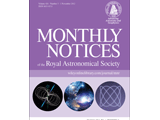Simulating high-z gamma-ray burst host galaxies
- /
- News
- /
- Simulating high-z gamma-ray burst...

R. Salvaterra (1), U. Maio (2), B. Ciardi (3), M. A. Campisi (3)
We investigate the nature of high-z host galaxies of long gamma-ray bursts (LGRBs) by means of state-of-the-art numerical simulations of cosmic structure formation and evolution of galaxies. We combine results from different runs with various box sizes and resolutions. By assigning to each simulated galaxy the probability to host an LGRB, assumed to be proportional to the mass of young stars, we provide a full description of the physical properties of high-z LGRB host galaxy population. We find that LGRBs at z > 6 are hosted in galaxies with typical star formation rates SFR ≃ 0.03–0.3 M⊙ yr−1, stellar masses M⋆ ≃ 106–108 M⊙ and metallicities Z ≃ 0.01–0.1 Z⊙. Furthermore, the ratio between their doubling time and the corresponding cosmic time seems to be universally equal to ∼0.1–0.3, independently from the redshift. The distribution of their UV luminosity places LGRB hosts in the faint end of the galaxy luminosity function, well below the current capabilities of space- or ground-based optical facilities. This is in line with recent reports of non-detection of LGRB hosts using extremely deep Hubble Space Telescope and Very Large Telescope observations. In conclusion, high-z LGRBs are found to trace the position of those faint galaxies that are thought to be the major actors in the re-ionization of the Universe.
Read the article published in "Monthly Notices of the Royal Astronomical Society" (V. 429 (3), pp. 2718-2726)
- INAF, IASF Milano, Milano, Italy
- Max Planck Institut für extraterrestrische Physik, München, Germany
- Max Planck Institut für Astrophysik, München, Germany